Top 10 News Highlights of Lancang-Mekong Cooperation in 2024
The year 2024 marks the 70th anniversary of the Five Principles of Peaceful Coexistence, the beginning of the second golden decade of the Belt and Road Initiative, and the 10th anniversary of the Lancang-Mekong Cooperation initiative. As the first new regional cooperation mechanism jointly established by the six countries in the Lancang-Mekong river basin, the Lancang-Mekong Cooperation has further solidified its leadership role and emerged as a “golden platform” for regional collaboration. The six Lancang-Mekong countries embody an enduring “bulldozer” spirit as they work to build demonstration zones for high-quality Belt and Road development, and pilot zones for the Global Development Initiative, the Global Security Initiative, and the Global Civilization Initiative. Their efforts aim to ensure that the community with a shared future for Lancang-Mekong countries takes root and produces tangible outcomes.
The CICG Asia-Pacific and the Yunnan International Communication Center for South and Southeast Asia, in collaboration with leading media outlets from Cambodia, Laos, Myanmar, Thailand, and Vietnam, have jointly selected the “Top 10 News Highlights of Lancang-Mekong Cooperation in 2024,” showcasing the impressive achievements, vast potential, and promising future of collaboration among the six Lancang-Mekong countries.
I. Political Mutual Trust Further Deepens Among Six Nations
On August 19, 2024, General Secretary of the CPC Central Committee and Chinese President Xi Jinping held talks with General Secretary of the CPV Central Committee and Vietnamese President To Lam, who was on a state visit to China, at the Great Hall of the People in Beijing.
Xi Jinping underscored that at the critical stage of national development and revitalization, China and Vietnam should, under the direction of the vision of building a community with a shared future, consolidate the development pattern featuring higher political mutual trust, more solid security cooperation, deeper practical cooperation, stronger public support, closer multilateral coordination and cooperation, and better management and resolution of differences. China is ready to maintain close strategic communication and high-level exchanges with Vietnam, firmly adhere to mutual support, actively explore ways to expand synergy between the Belt and Road Initiative (BRI) and the Two Corridors and One Economic Circle strategy, accelerate the “hard connectivity” of railway, expressway and port infrastructure, enhance the “soft connectivity” of smart customs, and jointly build a secure and stable industrial and supply chain. He called on the two sides to take the opportunity of celebrating the 75th anniversary of China-Vietnam diplomatic ties next year to jointly hold a series of activities such as the China-Vietnam Year of People-to-People and Cultural Exchanges to consolidate the popular support of the two countries. He also called for joint efforts to uphold the Five Principles of Peaceful Coexistence and other basic norms governing international relations, promote an equal and orderly multi-polar world and economic globalization that benefits all, uphold international fairness and justice and the common interests of developing countries, and work to build a community with a shared future for mankind.
To Lam stated that Vietnam is willing to maintain close high-level exchanges with China, share experiences in party governance and state administration, deepen strategic mutual trust, enhance synergy of development strategies, and enhance mutually beneficial cooperation in key areas such as national security, economic and trade investment, and cross-border infrastructure connectivity. They are set to successfully organize the China-Vietnam Year of People-to-People and Cultural Exchanges in 2025, promoting exchanges and cooperation among youth and localities to strengthen the social popular foundation between the two countries. Vietnam is committed to properly managing maritime differences with China and jointly upholding regional peace and stability. Vietnam supports and is ready to actively participate in the initiatives proposed by President Xi Jinping, which include building a community with a shared future for mankind, the Global Development Initiative, the Global Security Initiative, and the Global Civilization Initiative. Additionally, Vietnam is also willing to work closely with China to strengthen multilateral international cooperation, uphold multilateralism, safeguard international fairness and justice, and make positive contributions to promoting world peace and development.
During To Lam’s visit to China, the two sides issued the Joint Statement on Further Strengthening the China-Vietnam Comprehensive Strategic Cooperative Partnership and Promoting the Building of a Community with a Shared Future between the Two Countries.
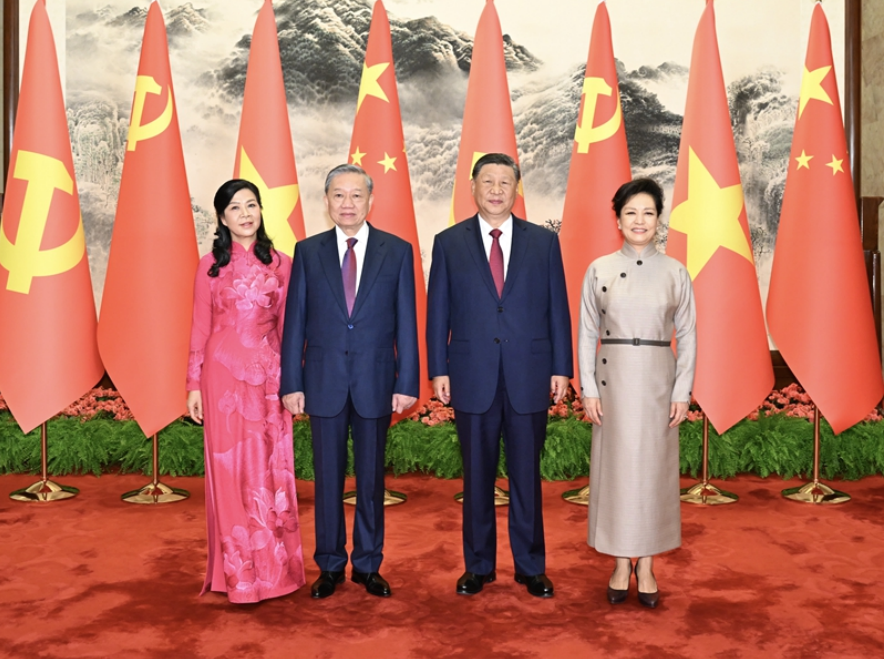
On August 19, 2024, General Secretary of the CPC Central Committee and Chinese President Xi Jinping held talks with General Secretary of the CPV Central Committee and Vietnamese President To Lam, who was on a state visit to China, at the Great Hall of the People in Beijing. Before the talks, President Xi Jinping and his wife Peng Liyuan took a photo with To Lam and his wife Ngo Phuong Ly. (Photo credit: Xinhua News Agency)
On November 7, the heads of government of Cambodia, Lao PDR, Myanmar, Thailand and Viet Nam, and President of the Asian Development Bank attended the regional mechanism conference held in China. Premier Li Qiang chaired the conference, emphasizing that China and the Mekong countries are a community with a shared future like a family. Faced with complex international and regional landscape, we need to work in solidarity, leverage our complementary economic strengths and further deepen practical cooperation in various fields.
China stands ready to work with Mekong countries to promote two-way opening up at a higher level and with greater scale, and build a more efficient and vibrant mega market. China stands ready to work with Mekong countries to deepen cooperation in industries of new energy battery, automobile and PV, and expand cooperation in emerging areas, such as clean energy, smart manufacturing, big data and smart cities. China stands ready to work with Mekong countries to deepen “hard connectivity” of infrastructure, and enhance “soft connectivity” on policies, laws, supervision, rules and standards. China stands ready to work with all sides to practice true multilateralism, advance coordinated development of GMS, Mekong-Lancang Cooperation and other mechanisms for an inclusive and mutually reinforcing cooperation atmosphere.
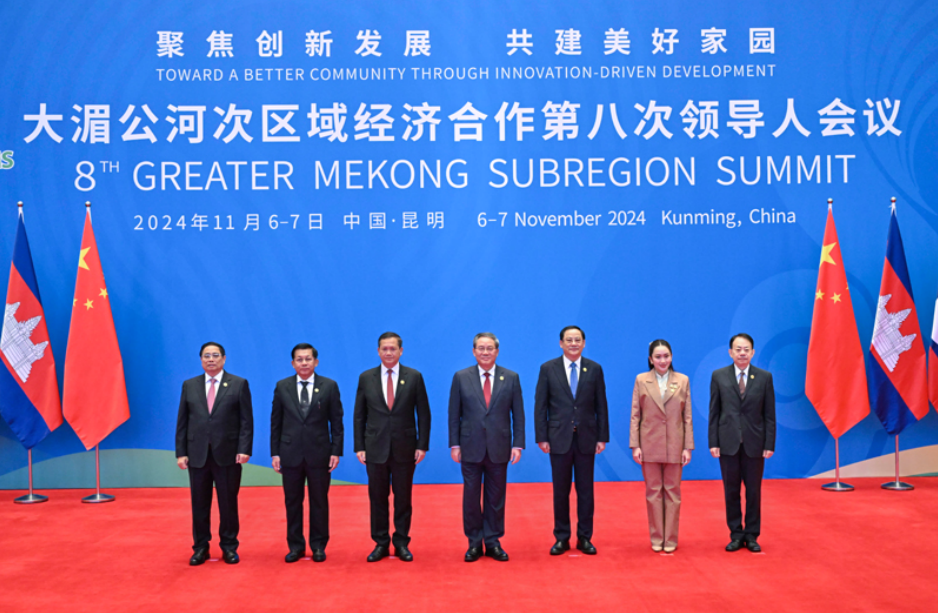
On November 7 2024, Chinese Premier Li Qiang participated in the 8th Greater Mekong Subregion Summit in Kunming. The photo features Li Qiang alongside the heads of government of Cambodia, Lao PDR, Myanmar, Thailand and Viet Nam, and President of the Asian Development Bank. (Photo credit: Xinhua News Agency)
[Read More]
In 2024, the political mutual trust between China and the Mekong countries continues to strengthen, while strategic trust deepens, as they work together to lead the way in building a community with a shared future for mankind.
In October, General Secretary of the CPC Central Committee and Chinese President Xi Jinping met with Thongloun Sisoulith, General Secretary of the Lao People’s Revolutionary Party and President of Laos, noting that both sides will continue to expand and strengthen the China-Laos Railway, advance the development of the China-Laos Economic Corridor, and create a model for Belt and Road cooperation.
In November, Xi Jinping met with Thai Prime Minister Paetongtarn Shinawatra, highlighting that the year 2025 marks the 50th anniversary of the establishment of China-Thailand diplomatic relations and the “Golden Year of Friendship”. Both sides should accelerate the construction of the China-Thailand Railway, expand cooperation in emerging fields such as new energy, digital economy and artificial intelligence, enhance cultural, educational, youth and other people-to-people exchanges, and organize such events as the enshrinement of the Buddha tooth relic in Thailand, to ensure that the China-Thailand friendship will be deeply rooted in the hearts of the two peoples and be passed on from generation to generation.
In December, Xi Jinping held talks with Hun Sen, President of the Cambodian People’s Party and Senate President, expressing China’s willingness to work with Cambodia to focus on the implementation of the new action plan on building a community with a shared future, continuously enrich the “diamond hexagon” cooperation framework, and contribute to the high-quality synergy between the Belt and Road Initiative and Cambodia’s Pentagonal Strategy.
In October, Chinese Premier Li Qiang paid official visits to Laos and Vietnam, during which he and the heads of the two countries agreed to continue approaching China-Laos and China-Vietnam bilateral relations from a strategic and long-term perspective, deepen comprehensive strategic cooperation and achieve more practical results in building a community with a shared future.
II. The 9th Lancang-Mekong Cooperation Foreign Ministers’ Meeting Marks the Beginning of a New Chapter in Cooperation
On August 16, 2024, the 9th Lancang-Mekong Cooperation Foreign Ministers’ Meeting took place in Chiang Mai, Thailand. Wang Yi, a member of the Political Bureau of the CPC Central Committee and the Chinese Foreign Minister, emphasized that the six Lancang-Mekong countries “share the same river and a common future,” highlighting their status as natural partners and eternal friendly neighbors. As they collectively advance towards modernization, China is ready to collaborate with the Mekong countries in building demonstration zones for high-quality Belt and Road development, and pilot zones for the Global Development Initiative, the Global Security Initiative, and the Global Civilization Initiative. This collaboration aims to ensure that the Lancang-Mekong community of shared future takes root and produces tangible results.
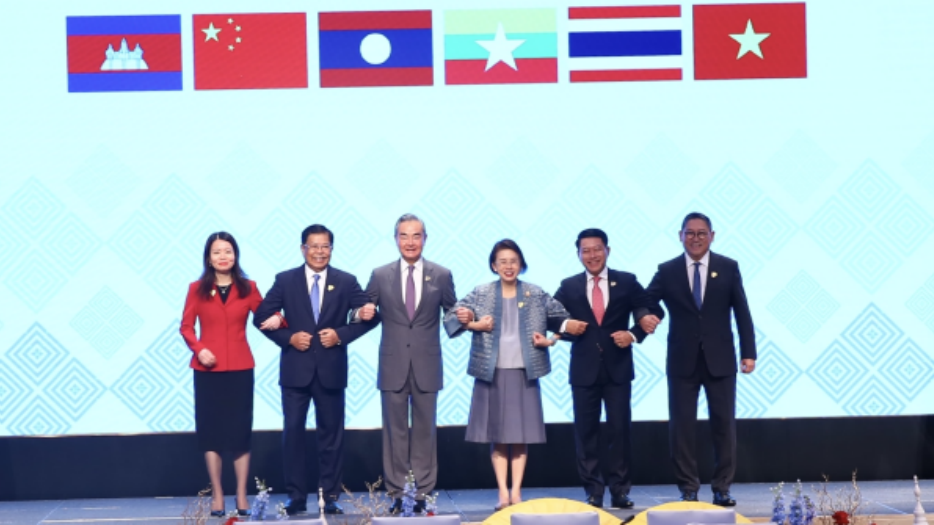
On August 16, 2024, local time, the 9th Lancang-Mekong Cooperation Foreign Ministers’ Meeting took place in Chiang Mai, Thailand. (Photo credit: Official website of the Chinese Ministry of Foreign Affairs)
The meeting resulted in the issuance of a joint press release and three statements focused on enhancing cooperation in water resources, clean air, and combating cross-border crime. Additionally, it released the 2023 Progress Report on the Five-Year Plan of Action on the Lancang-Mekong Cooperation (2023-2027), the 2024 List of Projects Funded by the Lancang-Mekong Cooperation Special Fund, and the Fact Sheet on the Implementation of the Hundred, Thousand, Ten Thousand Action Plan on Lancang-Mekong Agricultural Cooperation. Furthermore, a report from the six countries’ think tanks titled Building a Community of a Shared Future among Lancang-Mekong Countries: Common Vision and Paths to Realization was also released.
[Read More]
In 2024, the Lancang-Mekong Cooperation mechanism experienced rapid and comprehensive development, with the “3+5+X” framework maturing significantly. The six countries expanded their collaborative efforts, sharing development opportunities more broadly and working together to tackle various challenges.
In July, the 5th Meeting of the Joint Working Group on Lancang-Mekong Water Resources Cooperation took place in Laos. Participants engaged in in-depth discussions on key tasks, including the organization of the 2nd Ministerial Meeting of Lancang-Mekong Water Resources Cooperation, the joint implementation of the Five-Year Plan of Action on the Lancang-Mekong Water Resources Cooperation (2023-2027), and enhancements in the sharing of hydrological information between upstream and downstream regions of the basin, reaching broad consensus.
In December, the 1st Senior Officials’ Meeting on the Lancang-Mekong Cooperation Innovation Corridor Development was successfully held in Kunming, Yunnan. This meeting is part of a new mechanism established by the six Lancang-Mekong countries’ science and technology authorities to implement leaders’ consensus. It aims to enhance cooperation in scientific and technological innovation across various fields, including scientific and cultural exchanges, technology-driven poverty alleviation, industrial innovation, health and wellness, digital information, green technology, and innovation and entrepreneurship. The initiative seeks to jointly build a regional innovation corridor, contributing to the building of a community with a shared future among Lancang-Mekong countries.
In December, a high-level training class for officials from the ministries of justice (legal affairs) of the Lancang-Mekong countries, along with a consultation meeting on the legal and judicial exchange and cooperation mechanism, took place in Nanning, Guangxi. During this event, representatives from the ministries of justice (legal affairs) of the six Lancang-Mekong countries engaged in discussions aimed at promoting the establishment of a legal and judicial exchange and cooperation mechanism, ultimately reaching a consensus on future collaboration.
III. The Development of the China-Laos Railway Surpasses Expectations in Its First Three Years
On December 3, 2024, the China-Laos Railway celebrated its third anniversary of operations. In the past three years, the railway has cumulatively transported over 43 million passengers, including nearly 400,000 cross-border travelers. Additionally, it has moved more than 48 million tons of goods, with over 10.6 million tons being cross-border cargo. The range of cross-border goods transported has expanded to include more than 3,000 types, and the transportation network now reaches all 31 provinces, autonomous regions and municipalities in China, as well as 19 countries and regions such as Laos, Thailand, Vietnam, and Singapore. The number of source countries and regions for passengers has grown to 108, reflecting a development pace that has far exceeded expectations.
The brand influence of the “Lancang-Mekong Express” trains continues to expand, highlighted by the launch of several international freight services, including the “Lancang-Mekong-Chengdu-Chongqing-Europe Express,” “Shanghai-Yunnan Lancang-Mekong Line,” “Guangdong-Yunnan Lancang-Mekong Line,” and “Beijing-Yunnan Lancang-Mekong Line.” To date, a total of 1,600 international freight trains have been operated under the “Lancang-Mekong Express,” successfully transporting 640,000 tons of imported goods.
In September, China’s first cross-border tourism train, the “Starlight Lancang-Mekong Express,” departed from Kunming, marking the official launch of cross-border trains and tourism offerings on the China-Laos Railway.

A “Lancang” international train is running on the China-Laos Railway. (Photo credit: Yunnan Daily)
[Read More]
In 2024, the six Lancang-Mekong countries strengthened their connectivity initiatives, further enhancing the level of regional interconnectivity.
The construction of the China-Thailand Railway is progressing steadily, with the first multi-modal transport train departing from Kunming, China, to Ranong, Thailand. The international railway transport corridor connecting China, Laos, and Thailand has been further expanded, effectively promoting industrial capacity upgrades along the route and facilitating international trade and economic exchanges.
On the first anniversary of operations at the Siem Reap Angkor International Airport in Cambodia and the second anniversary of the official opening of the Phnom Penh-Sihanoukville Expressway (PPSHV Expressway), there has been a significant boost in logistics and personnel flow, contributing to economic growth. Cross-border railway cargo transport between China and Vietnam continues to thrive, and in June, the Dongzhong-Hoanh Mo bilateral port officially opened to the public, enhancing exchanges between the two countries and establishing a new trade route.
On December 10, the Guanlei Port in Yunnan successfully passed the national acceptance for its opening to the outside world. As the first port for Laos, Myanmar, Thailand, and other ASEAN countries to enter China via the Mekong River, this port has established China’s inaugural market for waterway border trade among local residents, and improved the port infrastructure and functional zones, regulatory facilities, as well as the smart port information management system, further promoting the facilitation of cross-border trade.
IV. The Six Lancang-Mekong Countries Work Together to Advance the “Safe Lancang-Mekong” Initiative
From August 6 to 7, 2024, the Meeting on Sharing Best Practices in Crime Suppression in the Lancang-Mekong Region and the Kick-Off Meeting for Joint Operation SEAGULL was held in Kunming, Yunnan. Over 50 representatives from the Ministry of Interior of Cambodia, the Ministry of Public Security of China, the Ministry of Public Security and the Ministry of National Defense of Laos, the Myanmar Police Force, the Royal Thai Police, the Ministry of Public Security of Vietnam, UNODC and INTERPOL attended this meeting.
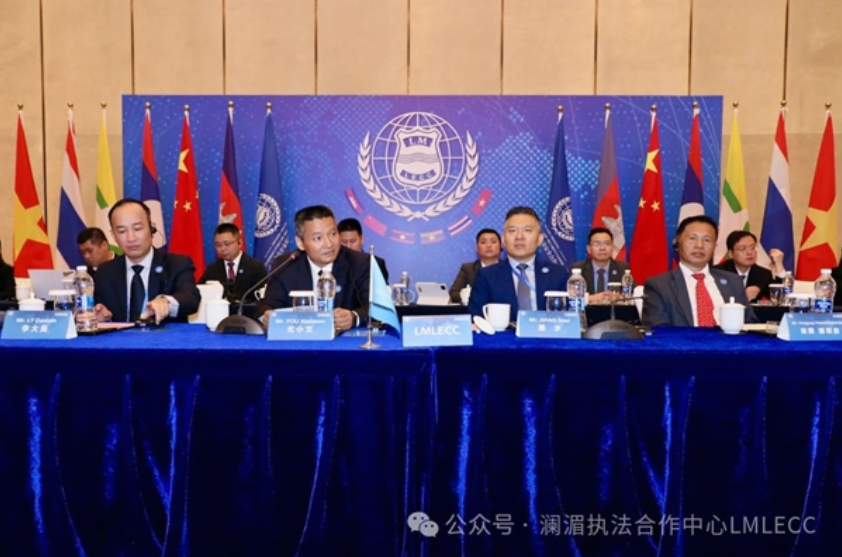
From August 6 to 7, 2024, the Meeting on Sharing Best Practices in Crime Suppression in the Lancang-Mekong Region and the Kick-Off Meeting for Joint Operation SEAGULL was held in Kunming. (Photo credit: Lancang-Mekong Integrated Law Enforcement and Security Cooperation Center)
Officials of the Lancang-Mekong Integrated Law Enforcement and Security Cooperation Center introduced the action plan for Joint Operation SEAGULL, which is the sub-operation of Joint Operation “Safe Lancang-Mekong” and focuses on the crackdown on telecom fraud and its related crimes as well as firearms smuggling. Participating law enforcement agencies will identify main criminal syndicates, capture main criminal suspects, rescue trapped laborers, confiscate criminal assets, strengthen border control, enhance crimes governance and prevention, and accumulate experiences for further joint strikes in the future. Representatives from six countries unanimously agreed and jointly announced to launch this five-month joint operation in six Lancang Mekong countries from August 7 to the end of 2024.
[Read More]
In 2024, the six Lancang-Mekong countries enhanced police law enforcement cooperation by conducting joint operations, sharing experiences in crime suppression, and achieving significant results in the field of security. These efforts effectively combated cross-border criminal activities, maintained regional peace and stability, and promoted regional prosperity and development.
On March 15, a handover ceremony took place in Phongsali Province, Laos for the law enforcement service station constructed by China to assist Laos in its border provinces, aimed at combating illegal activities in the region. Later, on June 13, the Safe Mekong Joint Operation 2024 was launched in Mangshi, Dehong Prefecture, Yunnan. This operation brought together China, Laos, Myanmar, Thailand, Cambodia, and Vietnam to form a regional joint force against drug trafficking. On August 16, the Joint Statement on Strengthening Cooperation in Combating Transboundary Crimes under the Lancang-Mekong Cooperation Framework was adopted at the 9th Lancang-Mekong Cooperation Foreign Ministers’ Meeting. As a result of these efforts, all large-scale telecommunications fraud parks in northern Myanmar near the Chinese border were dismantled. Additionally, the fourth-generation law enforcement vessels were completed for the Mekong River joint patrols and law enforcement missions by China, Laos, Myanmar and Thailand , culminating in the 148th joint patrol and law enforcement operation among China, Laos, Myanmar, and Thailand, thereby providing reliable support for regional law enforcement and security cooperation.
V. Cross-Border E-commerce Unlocks New Trade Opportunities
In recent years, the e-commerce market in the Mekong countries has experienced rapid growth, demonstrating significant economic potential. Chinese cross-border e-commerce companies are increasingly popular among consumers in these regions. In November, the 2024 China-Vietnam (Honghe) Border Economic, Trade, and Tourism Fair featured a dedicated cross-border e-commerce pavilion, the first of its kind at this event. The pavilion focused specifically on cross-border e-commerce, showcasing a variety of related businesses and products. A diverse range of goods was on display, including snacks, cosmetics, beauty products, electronics, household items, and plush toys. Alongside local enterprises from Yunnan, companies from Ankang in Shaanxi, Chifeng in Inner Mongolia, and major cities in Vietnam such as Ho Chi Minh City and Hanoi also participated.

The 2024 China-Vietnam (Honghe) Border Economic, Trade, and Tourism Fair featured a cross-border e-commerce pavilion. (Photo credit: Honghe Converged Media Center)
[Read More]
In 2024, the cooperation between China and the Mekong countries in the economic and trade sectors thrived, resulting in significant achievements.
From January 10-11, the 6th Lancang-Mekong Business Forum was held in Beijing, providing a platform to enhance economic development in the Lancang-Mekong region. On March 11, a business exchange meeting titled Yellow River-Mekong Dialogue: Ho Chi Minh City Special Session took place in Ho Chi Minh City, Vietnam, bringing together Shandong Province and cities along the Yellow River. On August 7, the launch ceremony for the Laos Enterprise Credit Information Platform was held in Vientiane, capital of Laos, providing strong information support for Lao enterprises to participate in international economic and trade exchanges. From September to October, the Lancang-Mekong Fruit Procurement Festival was organized in Kunming, China, and Yangon, Myanmar, fostering steady growth in agricultural trade in the Lancang-Mekong region. On November 4, the China-Cambodia Digital Economy Cooperation Forum was convened in Phnom Penh, Cambodia, opening up broader prospects for the continued development of bilateral economic and trade relations. On November 8, a dialogue on economic and trade logistics cooperation between Chinese and Vietnamese enterprises took place in Chongqing, where representatives from both sides signed seven cooperation memorandums. Finally, on November 18, the 2024 Yellow River-Mekong Exchange Week was held in Dezhou, Shandong Province, featuring activities such as trade and investment promotion sessions and business matchmaking meetings.
VI. Regional Cooperation for Sustainable Agricultural Development Accelerates
On December 4, 2024, the 2024 Lancang-Mekong Cooperation Forum for Agriculture, Agricultural Materials, Economy, and Trade was held in Nanning, Guangxi, focusing on the theme “Promoting the Green Sustainable Development of Agriculture and Agricultural Materials.” The forum facilitated in-depth exchanges on the latest developments between China and ASEAN, particularly the Mekong countries, in areas such as agriculture, agricultural materials, economy, trade, and technology. It aimed to strengthen connections through the exhibition and matchmaking of enterprises, products, and technologies, promote the sharing of regional agricultural resources, and enhance market expansion and trade cooperation, while supporting the green and sustainable development of regional agriculture.
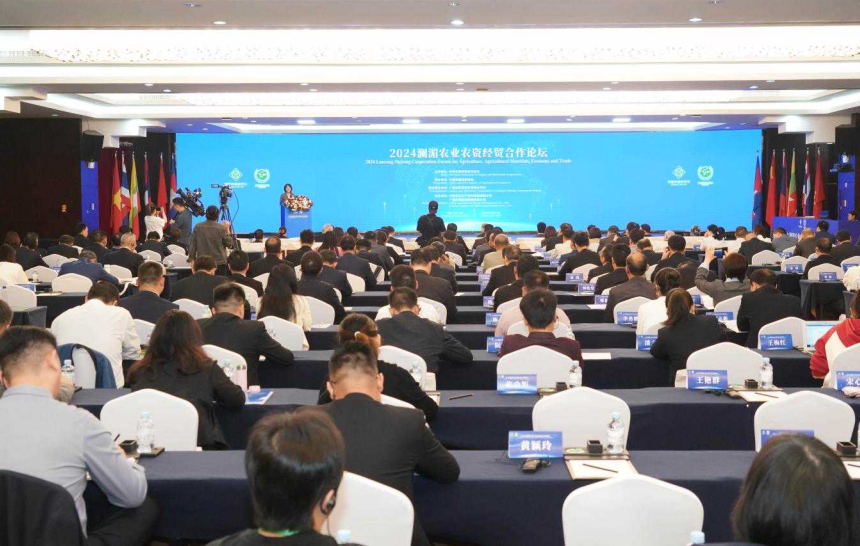
This photo shows the opening ceremony of the 2024 Lancang-Mekong Cooperation Forum for Agriculture, Agricultural Materials, Economy, and Trade. (Photo credit: The Federation of Supply and Marketing Cooperatives of Guangxi Zhuang Autonomous Region)
[Read More]
Promoting the digital transformation and green development of agriculture is a key focus of Lancang-Mekong Cooperation. In 2024, the agricultural sectors of the six Lancang-Mekong countries implemented the Five-Year Plan of Action on the Lancang-Mekong Agricultural Cooperation (2023-2027). New technologies and models were integrated into agricultural talent training, technical exchanges, and trade interactions, further deepening agricultural cooperation and stimulating regional economic prosperity and the well-being of the people.
On March 28, 2024, the concluding ceremony for the project Developing Community-based Forestry to Promote Agroforestry, supported by the Lancang-Mekong Cooperation Special Fund, took place in Naypyidaw, Myanmar. (Photo credit: Embassy of China in Myanmar)
In May, a talent training program for the development of the “Fish and Rice Corridor” in Cambodia was launched in Nanjing, Jiangsu, aimed at cultivating professional expertise in agricultural development and management. Also in May, a seminar on the development of the LMC fruit industry was held in Guangzhou, focusing on the growth of the fruit sector and fostering cooperation among participating countries. Additionally, representatives from the Lancang-Mekong nations visited Pu’er in Yunnan to discuss future agricultural environmental cooperation. In September, experts from China and Thailand engaged in discussions in Guangzhou regarding climate-smart water technology and innovative pilot programs for rice cultivation to address the impacts of climate change on agriculture while exploring methods to enhance water resource utilization. That same month, the pilot project for smart fisheries in Cambodia began implementation, aiming to improve local freshwater aquaculture and increase the supply of aquatic products. In October, joint law enforcement and fish fry release activities for fisheries between China and Laos were conducted in Jinghong City, Xishuangbanna, Yunnan, significantly enhancing the protection of aquatic biodiversity and resource recovery in the Lancang-Mekong basin. Meanwhile, the pilot project for Thailand’s smart durian orchards is making steady progress, enabling the optimization of agricultural practices, resource management, and cooperation among personnel in the orchards.
VII. Love Heart Journey Program Screens Over 80,000 Children for Congenital Heart Disease in the Lancang-Mekong Countries
Between 2018 and 2024, the Love Heart Journey initiative, spearheaded by the Fuwai Hospital of the Chinese Academy of Medical Sciences, fostered collaboration with Cambodia, Myanmar, and Laos through MOUs facilitated by the Fuwai Yunnan Hospital. This effort led to the screening of 85,403 children for health issues across the three nations. In a significant humanitarian gesture, 128 children diagnosed with congenital heart disease were given the opportunity for complimentary treatment in China -- 91 from Cambodia, 25 from Myanmar, and 12 from Laos. The program also included professional development, training 12 medical staff from these countries in China. The project has been lauded by the governments and citizens of the involved countries, setting a benchmark for healthcare diplomacy and fostering goodwill in the Lancang-Mekong region.
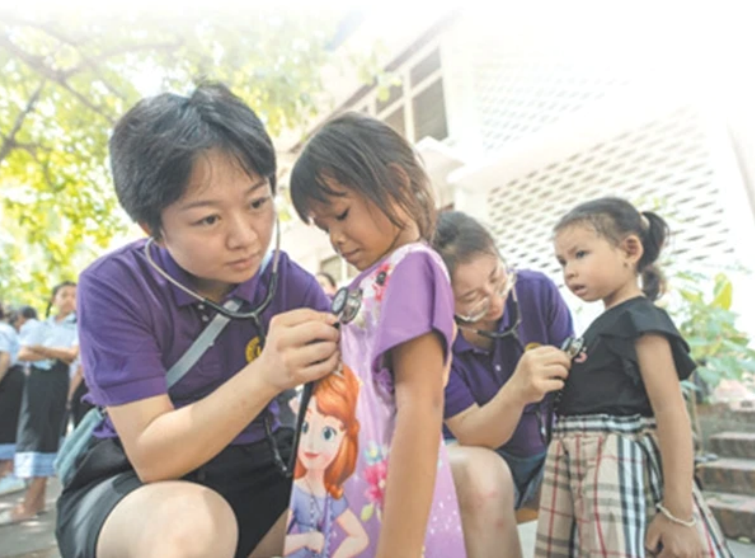
In Luang Prabang Province, located in northern Laos, a Chinese medical team offered free congenital heart disease screenings for local children. (Photo source: Xinhua News Agency)
[Read More]
In 2024, the six Lancang-Mekong countries enhanced exchanges and cooperation in key areas impacting people’s livelihoods, benefiting the people of all countries with more practical cooperation outcomes, while embodying the positive essence of “people-to-people connectivity.”
In terms of poverty alleviation, the Lancang-Mekong Cooperation has assisted local communities in lifting themselves out of poverty by improving infrastructure, initiating industrial development projects, and conducting capacity-building activities.
In November, a village-level poverty reduction project funded by the Lancang-Mekong Cooperation Special Fund was successfully completed. The initiative upgraded village roads and water supply facilities while also enhancing skills in vegetable cultivation and handicrafts, benefiting 2,700 people.
The Lancang-Mekong Sweet Spring Action emphasizes safe rural water supply as part of its water safety initiative. To date, the project has established over 100 demonstration points for rural water supply safety technology in countries such as Cambodia, Laos, and Myanmar, providing safe drinking water to tens of thousands of rural residents. Additionally, the project was included in the fifth Global Solicitation on Best Poverty Reduction Practices.
In the field of healthcare, free diagnoses, training programs, and exchange activities have provided high-quality medical services to the populations of the six countries. On July 2, local time, the 3rd Chinese Traditional Medicine Medical Team to Cambodia commenced a year-long medical assistance mission.
VIII. Six Countries Unite to Tackle Water and Drought Disasters
In September 2024, heavy rainfall from Super Typhoon Yagi resulted in sudden flood pressure along the lower reaches of the Lancang River and the Mekong River Basin. In response, China leveraged the regulatory capabilities of the Lancang River cascade reservoirs, adjusting the power generation load at the Jinghong Hydropower Station to reduce outflow, thereby effectively alleviating flood pressure along the Mekong River.
[Read More]
In alignment with the objective of strengthening resilience for sustainable development, the six Lancang-Mekong countries continued to implement the Lancang-Mekong Environmental Cooperation Strategy and Action Framework (2023-2027) along with the Green Lancang-Mekong Initiative throughout 2024, mobilizing regional efforts toward green development. In March, a floating photovoltaic power station in Ubon Ratchathani, built by China’s Dongfang Electric International Cooperation Co., Ltd., commenced its grid-connected power generation. This project marks Thailand’s first demonstration of an integrated system combining floating solar energy, clean hydropower, an efficient energy storage system, and intelligent energy management, making a significant contribution to the country’s green development. In May, the Green Lancang-Mekong Initiative: Roundtable Dialogue on Knowledge Sharing for Green, Low-Carbon, and Sustainable Infrastructure took place in Kunming, where representatives from the six countries exchanged experiences on low-carbon and sustainable development while envisioning future growth. In October, the Lancang-Mekong Green Cooperation Exhibition was held by the China Council for the Promotion of International Trade (CCPIT) in Bangkok, Thailand, where participants engaged in in-depth discussions on collaboration in green technology sectors, including new energy vehicles, photovoltaic energy storage, and energy efficiency and environmental protection technologies.

The floating photovoltaic power station in Ubon Ratchathani. (Photo credit: People’s Daily)
The six countries are actively implementing the Five-Year Plan of Action on the Lancang-Mekong Water Resources Cooperation (2023-2027). In response to natural disasters such as typhoons, floods, and droughts, they are enhancing practical cooperation in areas including sustainable development and utilization of water resources, hydrological information, disaster prevention and reduction, drinking water safety, dam safety, capacity building, personnel training, and basin-wide management. In July, a joint field survey was conducted in the source area of the Lancang River in Qinghai. From December 10 to 12, the Lancang-Mekong Water Resources Cooperation Center successfully held the Lancang-Mekong Trip in Yunnan, China. Approximately 50 participants, including diplomats from Cambodia, Laos, Myanmar, Thailand, and Vietnam based in China, along with Chinese representatives and journalists, engaged in in-depth discussions on the theme of “Joining Hands to Address Climate Change and Enhance Basin Flood and Drought Disaster Defense Capabilities.” All parties reaffirmed their commitment to implementing the consensus on Lancang-Mekong Cooperation and deepening practical collaboration in sustainable water resource development, aiming to elevate Lancang-Mekong water resource cooperation to new heights.
IX. The Expansion of the Scope of Visa-Free Countries Boosts Cultural Exchanges
On March 1, 2024, a visa exemption agreement for holders of ordinary passports between China and Thailand took effect, initiating a “visa-free era” for the two nations. On June 26, the Minister of Information, Culture, and Tourism of Laos issued the Implementation Rules on the Visa Policy and Tourism Regulations for Specific Tourist Groups in Visit Laos Year 2024. According to the document, from July 1 to December 31, 2024, Chinese group tourists (including residents from the Chinese mainland, Hong Kong, Macau, and Taiwan) are granted a visa-free entry for a stay period of no more than 15 days in Laos, provided that they travel to Laos under the arrangements of 42 designated travel agencies in Laos registered with the Ministry of Information, Culture and Tourism of Laos.

On March 1, 2024, a group of Chinese tourists posed for a photo at Muang Boran in Samut Prakan, Thailand. ( Photo credit: Xinhua News Agency)
Thanks to the incentive of visa facilitation policies, the number of Chinese citizens traveling to Mekong countries has been steadily increasing. Statistics indicate that Thailand received over 26 million foreign visitors in the first nine months of 2024, generating revenue of 1.21 trillion baht (1 yuan is approximately equal to 4.74 baht), with Chinese tourists topping the list at 5.25 million. In Laos, more than 2.1 million international tourists visited in the first half of 2024, with Chinese visitors ranking among the top three. By the end of August 2024, Cambodia welcomed around 4.3 million international tourists, over 530,000 of whom were from China, reflecting a nearly 50% year-on-year increase. Vietnam also experienced a surge in the inflow of Chinese tourists, with over 2.1 million visitors from China in the first seven months of 2024, representing a 200% increase.
In November, Chinese Premier Li Qiang announced that China would issue the Lancang-Mekong Visa to eligible business personnel in the five Mekong River countries, offering five-year multiple-entry visas for travel to China. This initiative has received a warm welcome and strong support across the Mekong nations.
[Read More]
The six Lancang-Mekong countries “share the same river and a common future” In 2024, these nations strengthened their cooperation in tourism, culture, education, media, and local exchanges, promoting a Lancang-Mekong culture featuring equality, sincerity, mutual assistance and kinship.
In 2024, tourism cooperation saw the implementation and promotion of visa-free policies between China and Thailand, as well as between China and Laos. Successful events, including the China-Cambodia People-to-People Exchange Year and Visit Laos Year 2024, strengthened ties among the six Lancang-Mekong countries. As China extends visa-free entry to more countries, the China-Laos Railway has become an increasingly popular transportation choice for tourists. In May and August, the Tea for Harmony Yaji Cultural Salon was held in Vietnam, Laos, Cambodia, and Myanmar, using tea as a means to discuss friendship while promoting cultural exchange and tourism cooperation among the Lancang-Mekong nations. In October, the China-Vietnam Detian-Ban Gioc Waterfall Cross-Border Tourism Cooperation Zone officially commenced operations, encouraging mutual travel between tourists from both countries and supporting the rapid recovery and healthy development of the tourism and aviation sectors. On November 27, the 2024 Lancang-Mekong Tourist Cities Cooperation Alliance Exchange Activity was held in Chongqing, laying out a new blueprint for regional tourism collaboration.
In the realm of cultural exchange, the 5th Lancang-Mekong Audiovisual Week took place from June 17 to 22 in Kunming, Yuxi, and other locations in Yunnan, with the goal of establishing a regional media cooperation brand through exceptional radio and television works. The “Food Is of Primary Importance to the People” Chinese Culinary Culture Exhibition was held on October 29 at the Confucius Institute of the National University of Laos, attracting local residents to experience the allure of Chinese culinary traditions. The 2024 China Video & Photography Week in Yangon, Myanmar, and the 18th Bangkok China Film Festival in Bangkok, Thailand, garnered positive responses and popularity among local audiences. In November, a series of activities for the China-Myanmar Cultural Exchange Week, themed “Heart to Heart for Warm-Up of Paukphaw Friendship, Hand in Hand for Mutual Learning of Civilizations,” was held in Yunnan, serving as a crucial platform to enhance cultural exchange and cooperation between China and Myanmar, strengthen the friendship between the two nations, and advance the building of a China-Myanmar community with a shared future.
In the realm of sports, events like the China-Thailand Ice Hockey Friendly Match continue to strengthen traditional friendships and promote mutual learning. On August 28, a handover ceremony for China’s sports technical assistance project to Cambodia was held in Phnom Penh. The successful implementation of this project has greatly improved the training and competitive levels of Cambodian sports teams, fostering strong bonds among Chinese and Cambodian athletes, coaches, and staff. In October, the 4th China Sepaktakraw Open of Lancang-Mekong Cooperation took place in Nanning, Guangxi. This event celebrated friendship through sepaktakraw and facilitated exchanges through sports, establishing an important platform for people-to-people connections among the six participating countries.
X. Fudan-1 (Lancang-Mekong Future Star) Satellite Successfully Launched
On September 24, 2024, the Fudan-1 (Lancang-Mekong Future Star) satellite was successfully launched from the Haiyang Oriental Spaceport in Shandong, aboard the Jielong-3 rocket. It entered its designated orbit successfully, marking a significant achievement. The Fudan-1 (Lancang-Mekong Future Star) satellite was jointly developed by Fudan University and Shanghai Aerospace Space Technology Co., Ltd. It aims to conduct multinational scientific research on solar atmospheric data and atmospheric data from the Lancang-Mekong region, providing an important platform for space observation and facilitating technological exchange and cooperation among the six countries.
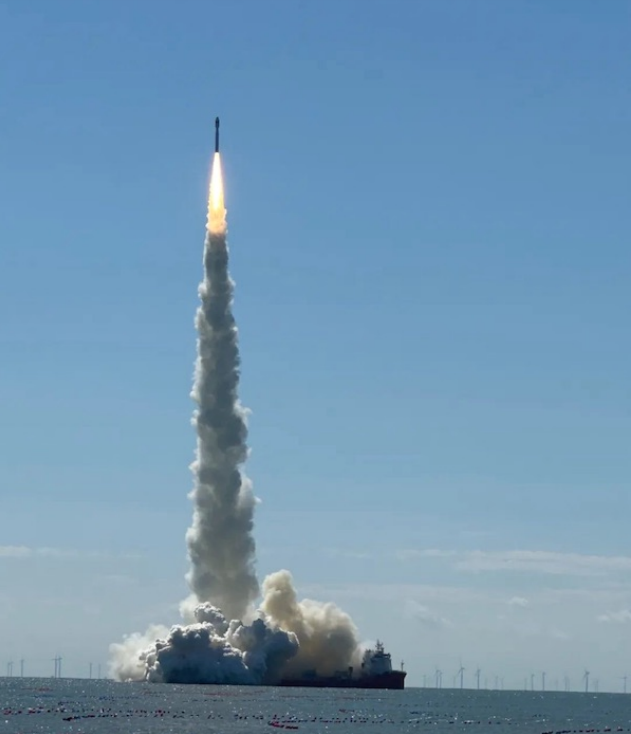
The Fudan-1 (Lancang-Mekong Future Star) satellite was successfully launched. (Photo credit: Fudan University)
[Read More]
In 2024, the youth from the six Lancang-Mekong countries engaged actively in dialogue and exchanges, strengthening friendships, exploring new opportunities for Lancang-Mekong cooperation, and voicing fresh perspectives on regional development.
The All-China Youth Federation hosted the Lancang-Mekong Young Entrepreneurs Forum, where the Kunming Declaration on Young Entrepreneurs Cooperation among the Lancang-Mekong Countries was issued. During the Lancang-Mekong Week, Fudan University held the 3rd Lancang-Mekong Youth Online: Governance and Development in the Lancang-Mekong Region, and other activities such as the Lancang-Mekong food sharing. Shanghai University of Applied Technology organized youth interviews themed “Our Stories with the China-Laos Railway.” In Yunnan, the “Generation Z” Lancang-Mekong Short Video Show and the “Hi China” Yunnan Tour were held, fostering mutual understanding and identity among the youth of the six countries. Moreover, the 2024 Lancang-Mekong Young Scientists Roundtable Forum, the China-Cambodia Youth Dialogue, and the Views of Young Thai Politicians on China organized by the Embassy of China in Thailand underscored the essential role of youth in fostering regional economic development and instilled a sense of responsibility among young individuals.
Regarding talent development, initiatives like the Lancang-Mekong Youth Training Camp for Innovation and Entrepreneurship, the Leadership Training Workshop for Young Professionals in Water Science, the 8th Youth Innovation Competition on Lancang-Mekong Region’s Governance and Development, and the Seminar on Building Water Sector Youth Leadership Network in the Lancang-Mekong Region offered valuable training opportunities and platforms for skill demonstration. The youth in the Lancang-Mekong region are not only proactive in their individual fields but also engage in cross-border collaboration to tackle challenges and work together towards a brighter future.
By YICC reporters